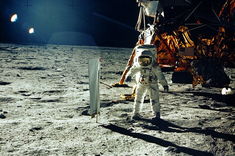“The Last Steps,” a new documentary short, chronicles the Apollo 17 mission that landed the last men on the moon in 1972.
A new documentary short looks back at the last time humanity ventured beyond low-Earth orbit.
“The Last Steps ,” which premiered on Saturday (Oct. 8) at the Hamptons International Film Festival in East Hampton, New York, chronicles the journey of Apollo 17, the United States’ sixth and last moon landing in December 1972.
“The theme of our mission is that this isn’t the end,” says Apollo 17 commander Gene Cernan in a rarely-seen pre-flight interview that is playing as “The Last Steps” begins. “We’ve just begin [sic] to crawl with the Apollo program as mankind. We’re just now hoping that we can learn to walk and then press onto the future.” [NASA’s 17 Apollo Missions in Pictures ]
Produced by CNN Films and Great Big Story, CNN’s video network, “The Last Steps” relies solely on original NASA footage — most of it having been shot by Cernan and his Apollo 17 crew mates, Harrison Schmitt and Ron Evans.
“Unlike other films that have blended archival footage with interviews or narration from today, our film is unique in that we use only archival material, in other words transmission audio, original still photography and original film captured by the astronauts,” said Todd Miller, “Last Steps” director, in an interview with collectSPACE.com, “thus giving the viewer a truly direct cinema experience of our last trip to the lunar surface.”
Launched from Earth on Dec. 7, 1972, Cernan and Schmitt spent three days on the moon, exploring the Taurus-Littrow valley over the course of three moonwalks. They were the last to drive a lunar rover and collected 741 rock and soil samples . Evans made the last deep space extra-vehicular activity (EVA or spacewalk) on the way home.
“The Last Steps” follows the Apollo 17 mission from just before liftoff through to its safe splashdown in the Pacific Ocean on Dec. 14, 1972. The footage includes scenes that will be familiar to space enthusiasts, but also material that has not been widely-viewed beyond the NASA archives.
“We came across some rare archival footage of the Apollo 17 mission while working on our next feature-length film,” said Miller, who produced and directed “Dinosaur 13,” the 2014 Emmy Award-winning documentary about the largest and most complete Tyrannosaurus Rex fossil. “While the footage really didn’t fit in the context of the feature-length movie, I thought it would be perfect for a short that utilized only archival materials.”
These rarely-viewed segments include film from inside the geology support room at Mission Control in Houston.
“Here’s the shadow — you see that shadow coming right down here,” says Apollo 13 commander Jim Lovell, as he works with scientists in the room as they watch the Apollo 17 astronauts work on the moon.

0 of 10 questions complete
All of the footage underwent a digital intermediate process that color-corrected and graded the footage for theatrical presentation.
“Select shots that were deemed too low quality, such as the ‘suiting-up’ shots and launch shots, were scanned from 16mm negative source from the film vaults at the National Archives in Washington,” Miller described. “We also did a complete sound design and 5.1 mix that cleaned up all of the digitized transmission audio, flight control room audio, and any other original audio source.”
Following its world premiere at the Hamptons International Film Festival, “The Last Steps” is set to debut on Great Big Story later this fall, in time for the 44th anniversary of the mission.
“My hope [for ‘Last Steps’] is that the accomplishments of Apollo 17 and the Apollo program are appreciated by a new, younger audience who maybe aren’t aware of how amazing a feat it was,” said Miller. “And at the same time, I hope that the film reminds all of us that when we come together for what seems to be an impossible goal we can achieve great things.”
collectSPACE.com editor Robert Pearlman served as historical consultant on “The Last Steps.”
Follow collectSPACE.com on Facebook and on Twitter at @collectSPACE . Copyright 2016 collectSPACE.com. All rights reserved.

Comments are closed.